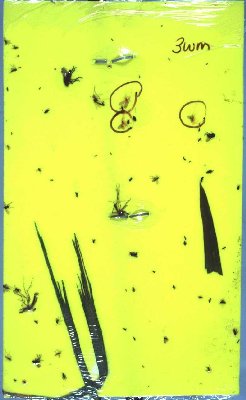Monitoring Wheat Midge With Sticky Traps
Wheat midge larvae feed on young developing wheat seeds, and can reduce crop yield and quality. Although the damage can be managed by applying insecticides as the wheat flowers, not all fields require protection annually, and determining whether an insecticide would be economical or not is difficult.
Wheat midge are hard to monitor because mature larvae and pupae are hidden in the soil; adults are small, short-lived insects, that are only active at twilight and usually hidden in the crop canopy; eggs are microscopic; and the feeding larvae are hidden within florets. The current recommendation is to monitor wheat from heading until anthers are visible on the heads, counting adults at sunset, and apply insecticide when densities reach one adult per four or five wheat spikes. Farmers find counting adults in the canopy difficult since it is done as the light fades, and often the insects are difficult to see.
As an alternative to monitoring wheat midge at sunset, sticky card traps can be used to monitor wheat midge in wheat fields, and make pest control decisions. The traps are readily available, inexpensive, and easy to set-up. Ten traps provide an effective sample size spaced at about 10 m intervals within the crop. The traps should be positioned at the height of the wheat heads, as the heads are beginning to emerge from the flag leaf, and left in place for three nights. This interval is sufficient to catch wheat midge if they are active, and leaves sufficient time to arrange for an insecticide application at the correct crop stage.
Trap Set-up
Yellow card traps (3 X 5 inches) are fastened onto wooden or bamboo stakes with the long axis of the card vertical. The paper covering one of the sticky surfaces is peeled off to expose the sticky surface. Traps are placed at the same height as the wheat heads. The ten traps should be placed 10-15 m apart in a row about 10-15 m in from the edge in spring wheat fields.
Traps should be placed in spring wheat fields as heads begin to emerge from the boot. After three nights, traps are collected, and the number of wheat midge on each trap are counted.
Spring wheat is not attractive to the wheat midge for egg laying prior to the emergence of the head, and larvae do not damage wheat kernals if the eggs are laid after flowering. Thus, timing of trap placement is important to properly assess wheat midge thresholds and have time for control. Winter wheat in Manitoba is not usually susceptible to wheat midge because it flowers before wheat midge adults are present.
Economic Thresholds
The following economic thresholds are based on data correlating the number of wheat midge caught in sticky traps with the number of larvae that were later found in the wheat heads. These thresholds can be used to predict the risk of an economic infestation in a field. Note, however, that economic thresholds are based on probabilities of an infestation occurring in a field (such as a 1 in 20 chance of economic damage if 0 wheat midge are found in the traps) and are not guarantees of no damage.
Number of Wheat Midge Adults per 10 Traps |
Recommendation |
Rationale Based on Research Findings |
| 0-3 | An application of insecticide is not needed |
If no wheat midge adults were caught, only 5% of fields had damaging levels of larvae; with 1-3 adults, 6% of fields had damaging levels (causing >15% yield loss). |
| 4-9 | Farmers producing high grade wheats, particularly seed growers or producers of high protein common and durum wheat, will often benefit from an insecticide application. An insecticide may not be needed if lower grades for the wheat are expected. |
An insecticide application would not have been economical in 48% of the fields in the trials, but in the remaining 52% of the fields an insecticide application would have been economical. |
| 10 or more | an insecticide application is usually warranted |
An insecticide would have been economical in 60% of the fields, based on levels of larvae in the wheat heads. |
If temperatures in the evening are low (below 15° C), winds are high (above about 10 km/hr), or it is raining, the midge are less likely to be active in the field and this will influence the numbers caught on the sticky card traps. This needs to be considered when interpreting the numbers caught on the sticky cards. Several consecutive evenings of unfavorable weather for egg laying right after heading may also reduce the risk of the wheat being infested to an economic level by the midge, however.
Routine use of this monitoring method should eliminate most unnecessary applications of insecticides, and help assure that the benefits of insecticide applications exceed the cost.
Identifying Wheat Midge On The Traps
Wheat midge adults are very small orange flies about half the size of a mosquito, and about 2 to 3 mm long. It is important to be able to distinguish wheat midge on the traps from other flies that may be on the traps, or plant debris such as anthers from the wheat that may have fallen onto the traps. In the figure below, wheat midge on the sticky card trap have been circled.
Material For Card Traps
Many large nurseries will carry yellow card traps, although often they do not carry the 3"X5" size. So cards may have to be cut to the proper size.

Even-Spray in Winnipeg has 10"X16" yellow sticky cards, which could be cut to make the 3"X5" cards needed for wheat midge monitoring.
Even-Spray Bay 2-851 Lagimodiere Boulevard
Winnipeg, Manitoba R2J 3K4
Phone: 204-237-9095
Fax: 204-231-0710
Toll Free: 1-800-665-3836
PheroTech sells card traps in the 3"X5" size needed for wheat midge monitoring.
Phero Tech
7572 Progress Way
Delta, British Columbia V4G 1E9
Phone: 604-940-9944
Fax: 604-940-9433
Toll Free: 1-800-665-0076
